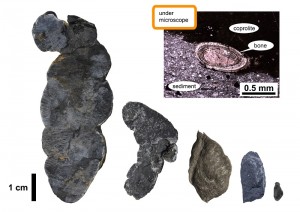The oldest "fossilized poop" from Japan Evidence of marine ecosystem recovery from end-Paleozoic mass extinction

The mass extinction that took place at the Paleozoic-Mesozoic boundary (approx.252 million years ago) killed around 95 per cent of marine species, greatly simplifying the structure of the marine food chain. In past research it was thought that it took more than 5 million years for the marine ecosystem to fully recover from its collapse. However, marine animal fossils from the Early Triassic age, which came just after the mass extinction, are quite rare, which may have lead researchers to underestimate the marine biodiversity at that time.

Coprolites (fossil feces) of various sizes, and a microscope image (upper right), showing a vertebrate bone included in a coprolite.
© 2014 Yasuhisa Nakajima.
This study focused not on rare body fossils such as bones but on more commonly found “coprolites,” which are fossilized feces of animals, and showed that a complex food chain was already reestablished in the Early Triassic marine ecosystem.
Postdoctoral Fellow Dr. Yasuhisa Nakajima at the University of Bonn in Germany and graduate student Mr. Kentaro Izumi at the University of Tokyo found more than 60 coprolites from the Early Triassic marine stratum called the “Osawa Formation” in Minamisanriku Town, Miyagi Prefecture, northeastern Japan. The variety in coprolite size, ranging from a few milliliters to 7 centimeters in maximum dimension, suggested that the producing animals also varied in body size. Moreover, microstructural analysis using polarized light microscopy revealed that some of the coprolites included small bones from vertebrates. This evidence shows that a complex marine ecosystem with primary producers, primary consumers, small vertebrates and larger predators had fully recovered by 5 million years after the mass extinction at the Paleozoic-Mesozoic boundary.
As this study shows, Japanese geological fields such as Minamisanriku town are hotspots providing important evidence that could reveal the history of the ecosystem over the past several hundred millions of years. It is clear that further excavation in these high-potential fields should be encouraged.
Press release (Japanese)
Paper
Yasuhisa Nakajima, Kentaro Izumi,
“Coprolites from the upper Osawa Formation (upper Spathian), northeastern Japan: Evidence for predation in a marine ecosystem 5 Myr after the end-Permian mass extinction”,
Palaeogeography, Palaeoclimatology, Palaeoecology Online Edition: 2014/9/27 (Japan time), doi: 10.1016/j.palaeo.2014.08.014.
Article link







